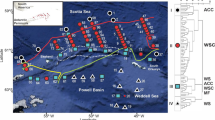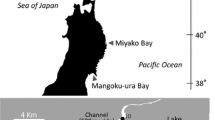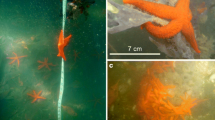Abstract
Spatial distribution patterns of the different life stages of Euphausia superba in the region of the South Shetland Islands and southern Scotia Sea (Antarctica) were assessed based on scientific survey data collected in January and February of 2010. Adults, eggs, nauplii, metanauplii, calyptopis I-III, and furcilia I-II were found in the investigation. The abundance of larvae averaged 1 172.8 ind./m2, with calyptopis I and II as the dominant stages. Habitat occupancy patterns varied among Euphausia superba at different stages, and three sub-regionswere identified by cluster analysis. The degree of larval development increased fromwest to east. Larvae were not observed north of the South Shetland Islands. Calyptopis I was predominant in the water between Elephant Island and the South Orkney Islands, which featured no thermocline. Older stages, including calyptopis II and III and furcilia I and II, were common in north and northeast of the South Orkney Islands, which were characterized by high temperature and high chlorophyll concentration. Distribution and abundance of the early life stages of E. superba were associated with specific environmental conditions. According to Biota-Environment matching (BIOENV), the distributions of E. superba larvae were correlated with a combination of temperature at the surface and 200m, and 0–100 mintegrated chlorophyll a concentration.
Similar content being viewed by others
References
Atkinson A, Siegel V, Pakhomov E, et al. 2004. Long-term decline in krill stock and increase in salps within the Southern Ocean. Nature, 432: 100–103
Bersch M, Becker G A. 1986. The surface expression of the western Weddell-Scotia confluence. Meeresforschung, 31: 58–68
Brinton E, Huntley M, Townsend A W. 1986. Larvae of Euphausia superba in the Scotia Sea and Bransfield Strait in March 1984-development and abundance compared with 1981 larvea. Polar Biol, 5: 221–234
Clarke K R. 1993. Non-parametric multivariate analyses of changes in community structure. Aust J Ecol, 18: 117–143
Clarke K R, Ainsworth M. 1993. Amethod of linking multivariate community structure to environmental variables. Mar Ecol Prog Ser, 92: 205–219
Clarke K R, Gorley R N. 2006. PRIMER v6: User Manual/Tutorial. Plymouth: PRIMER-E
Deacon G E R. 1933. A general account of the hydrology of the South Atlantic Ocean. Discovery Rep, 7: 171–238
Elias M C. 1990. Effects of photoperiod, phytoplankton level and temperature on the growth, development and survival of larval Euphausia superba (Dana) [dissertation]. Santa Barbara: University of California, 112
Everson I. 2000. Distribution and standing stock. In: Everson I, ed. Krill: Biology, Ecology and Fisheries-Fish and Aquatic Resources, Series 6. Oxford: Blackwell Science, 194–201
Fraser F C. 1936. On the development and distribution of the young stages of krill (Euphausia superba). Discovery Rep, 14: 1–192
Frazer T K, Ross R M, Quetin L B, et al. 1997. Turnover of carbon and nitrogen during growth of larval krill, Euphausia superba Dana: a stable isotope approach. J ExpMar Biol Ecol, 212: 259–275
Foster T D, Middleton J H. 1984. The oceanographic structure of the eastern Scotia Sea: 1. Physical oceanography. Deep-Sea Res, 31: 529–550
Hagen W. 1988. On the significance of lipids in Antarctic zooplankton. Reports on Polar Research, 49: 1–129
Hempel I. 1985. Variation in geographical distribution and abundance of larvae of antarctic krill, Euphausia superba in the southern Atlantic Ocean. In: Siegfried W R, Condy P R, Laws R M, eds. Antarctic Nutrient Cycles and Food Webs. Berlin: Springer, 304–307
Hempel I, Hempel G. 1986. Field observations on the developmental ascent of larval Euphausia superba (Crustacea). Polar Biol, 6: 121–126
Hofmann E E, Klinck J M, Locarnini R A, et al. 1998. Krill transport in the Scotia Sea and environs. Antarct Sci, 10: 406–415
Hofmann E E, Lascara C M. 2000. Modelling the growth dynamics of Antarctic krill Euphausia superba. Mar Ecol Prog Ser, 194: 219–231
Huntley M, Brinton E. 1991. Mesoscale variation in growth and early development of Euphausia superba Dana in the western Brans-field Strait region. Deep-Sea Res Part A, 38: 1213–1240
Ikeda T. 1984. Development of the larvae of the Antarctic krill (Euphausia superba Dana) observed in the laboratory. J Exp Biol Ecol, 75: 107–117
Kruskal J B. 1964. Multidimential scaling by optimizing goodness of fit to a nonmetric hypothesis. Psychometrika, 29: 1–27
Mackintosh N A. 1972. Life cycle of Antarctic krill in relation to ice and water conditions. Discovery Rep, 36: 1–94
Makarov R R. 1972. The life history and peculiarities of the distribution of Euphausia superba Dana. Tr Vses Nauchno-Issled Rybnogc Okeanogr (in Russian), 77: 85–92
Makarov R R. 1974. Larvae of Euphausia superba Dana in plankton from the Sea of Scotia. Tr Vses Nauchno-Issled Rybnogo Okeanogr (in Russian), 99: 84–103
Makarov R R. 1979. Early larval stages of antarctic euphausiids (Crustacea, Euphausiacea). Zoologischeskii Zhurnal (in Russian), 58: 314–321
Marr J W S. 1962. The Natural History and Geography of the Antarctic krill (Euphausia superba Dana). Discovery Rep, 32: 33–464
Marschall H P, Hirche H J. 1984. Development of eggs and nauplii of Euphausia superba. Polar Biol, 2: 245–250
Meredith M P, King J C. 2005. Rapid climate change in the ocean west of the Antarctic Peninsula during the second half of the 20th century. Geophys Res Lett, 32: L19604
Meyer B, Atkinson A, Blume B, et al. 2003. Feeding and energy budgets of larval Antarctic krill Euphausia superba in summer. Mar Ecol Prog Ser, 57: 167–177
Muench R D, Huber B A, Gunn J T, et al. 1992. The Weddell-Scotia marginal ice zone: physical oceanographic conditions, geographical and seasonal variability. J Mar Syst, 3: 169–182
Murphy E J, Thorpe S E, Watkins J L, et al. 2004. Modeling the krill transport pathways in the Scotia Sea: spatial and environmental connections generating the seasonal distribution of krill. Deep-Sea Res II, 51: 1435–1456
Nicol S, Foster J, Kawaguchi S. 2012. The fishery for Antarctic krill-recent development. Fish Fish, 13: 30–40
Patterson S L, Sievers H A. 1980. The Weddell-Scotia Confluence. J Phys Oceanogr, 10: 1584–1610
Quetin L B, Ross RM. 1984. Depth distribution of develo** Euphausia superba embryos, predicted from sinking rates. Mar Biol, 79: 47–53
Rakusa-Suszczewski S. 1984. Krill larvae in the Atlantic sector of the Southern Ocean during FIBEX 1981. Polar Biol, 3: 141–147
Ross R M, Quetin L B. 1986. How productive are antarctic krill?. Bioscience, 36: 264–269
Ross R M, Quetin L B. 1989. Energetic cost to develop the first feeding stage for Euphausia superba Dana and the effects of delays in food availability. J ExpMar Bio Ecol, 133: 103–127
Ross R M, Quetin L B, Kirsch E. 1988. Effect of temperature on developmental times and survival of early larval stages of Euphausia superba Dana. J ExpMar Bio Ecol, 121: 55–71
Schmidt K, Atkinson A, Venables H J, et al. 2012. Early spawning of Antarctic krill in the Scotia Sea is fuelled by “superfluous” feeding on non-ice associated phytoplankton blooms. Deep-Sea Res II, 59–60: 159–172
Shulenberger E, Wormuth J H, Loeb V J. 1984. A large swarm of Euphausia superba: overview of path structure and composition. J Crustac Biol, 4: 75–95
Spiridonov V A. 1995. Spatial and temporal variability in reproductive timing of Antarctic krill (Euphausia superba Dana). Polar Biol, 15: 161–174
Trivelpiece W Z, Hinke J T, Miller A K, et al. 2011. Variability in krill biomass links harvesting and climate warming to penguin population changes in Antarctic. Proc Natl Acad Sci USA, 108: 7625–7628
Wang Rong. 1989. Distribution and abundance of eggs and larvae of antarctic krill (Euphausia superba Dana) in antarctic Peninsula area. Chin J Oceanol Limnol, 7: 97–104
Witek Z, Koronkiewicz A, Soszka G J. 1980. Certain aspects of the early life history of krill Euphausia superba Dana (Crustacea). Pol Polar Res, 1: 97–115
**ao Cunde. 2008. Changes in antarctic climate system: past, present and future. Adv Clim Chang Res (in Chinese), 4: 1–7
Author information
Authors and Affiliations
Corresponding author
Additional information
Foundation item: Project on the exploration of fishery resources in the offshore supported by the Ministry of Agriculture (2010–2013); Chinese Polar Environment Comprehensive Investigation and Assessment Programes under contract No. CHINARE2012∼2016-01-06.
Rights and permissions
About this article
Cite this article
Gao, Q., Xu, Z., Huang, H. et al. Geographical distribution and age composition of Euphausia superba larvae (Crustacea: Euphausiacea) in the South Shetland Islands region and southern Scotia Sea in relation to environmental conditions. Acta Oceanol. Sin. 32, 59–67 (2013). https://doi.org/10.1007/s13131-013-0378-1
Received:
Accepted:
Published:
Issue Date:
DOI: https://doi.org/10.1007/s13131-013-0378-1




